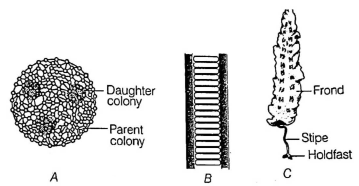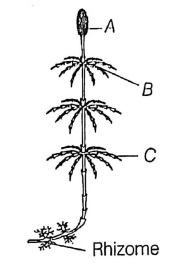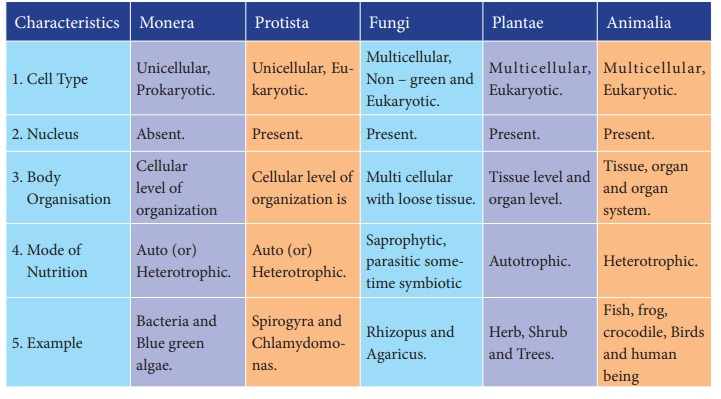Plant Kingdom TS
Quiz Summary
0 of 50 Questions completed
Questions:
Information
You have already completed the quiz before. Hence you can not start it again.
Quiz is loading…
You must sign in or sign up to start the quiz.
You must first complete the following:
Results
Results
0 of 50 Questions answered correctly
Your time:
Time has elapsed
You have reached 0 of 0 point(s), (0)
Earned Point(s): 0 of 0, (0)
0 Essay(s) Pending (Possible Point(s): 0)
Categories
- Not categorized 0%
- 1
- 2
- 3
- 4
- 5
- 6
- 7
- 8
- 9
- 10
- 11
- 12
- 13
- 14
- 15
- 16
- 17
- 18
- 19
- 20
- 21
- 22
- 23
- 24
- 25
- 26
- 27
- 28
- 29
- 30
- 31
- 32
- 33
- 34
- 35
- 36
- 37
- 38
- 39
- 40
- 41
- 42
- 43
- 44
- 45
- 46
- 47
- 48
- 49
- 50
- Current
- Review
- Answered
- Correct
- Incorrect
-
Question 1 of 50
1. Question
In liverworts asexual reproduction takes place by the formation of specialised structures called
CorrectIncorrectHint
[NCERT-I-29]
Asexual reproduction in liverworts takes place by fragmentation of thalli, or by the formation of specialised structures called gemmae (sing. gemma). Gemmae are green, multicellular, asexual buds, which develop in small receptacles called gemma cups located on the thalli. -
Question 2 of 50
2. Question
Match the following
a. Lycopsida (i) Dryopteris
b. Pteropsida (ii) Selaginella
c. Sphenopsida (iii) Psilotum
d. Psilopsida (iv) EquisetumCorrectIncorrectHint
(3)
[N CERT-I-32]
Psilopsida (Psilotum); Lycopsida (Selaginella, Lycopodium), Sphenopsida (Equisetum) and Pteropsida (Dryopteris, Pteris, Adiantum). -
Question 3 of 50
3. Question
Diplontic life cycle is present in
(a) Cycas
(b) Eucalyptus
(c) Funaria
(d) Dictyota
(e) AdiantumCorrectIncorrectHint
(4)
[NCERT-I-31,32,33]
All seed-bearing plants i.e. gymnosperms and angiosperms, follow this pattern. -
Question 4 of 50
4. Question
Characteristic of angiosperms which distinguish them from gymnosperms
CorrectIncorrectHint
(4)
[NCERT-I-34]
The pollen tubes enter the embryo-sac where two male gametes are discharged. One of the male gametes fuses with the egg cell to form a zygote (syngamy). The other male gamete fuses with the diploid secondary nucleus to produce the triploid primary endosperm nucleus (PEN). Because of the involvement of two fusions, this event is termed as double fertilisation, an event unique to angiosperms. During these events the ovules develop into seeds and the ovaries develop into fruit. -
Question 5 of 50
5. Question
Given below are two statements :
Statement I : Fusion between one large, non motile, static female gamete and a smaller motile male gamete is called oogamous.
Statement II : At least half of total carbon dioxide fixation on Earth is carried out by algae through photosynthesis.
Choose the correct answer from the options given belowCorrectIncorrectHint
(4)
[NCERT-I-24,26]
Fusion between one large, non motile, static female gamete and a smaller motile male gamete is called oogamous.At least half of total carbon dioxide fixation on Earth is carried out by algae through photosynthesis.
-
Question 6 of 50
6. Question
Given below are two statements :
Statement I : In Rhodophyceae food is stored as complex carbohydrate in the form of mannitol.
Statement II : Mannitol starch is very similar to amylopectin and glycogen in structure.
Choose the correct answer from the options given belowCorrectIncorrectHint
(1)
[NCERT-I-27]
In Rhodophyceae food is stored as floridean starch which is very similar to amylopectin and glycogen in structure. -
Question 7 of 50
7. Question
Conifers are adapted to tolerate extreme environmental conditions because of:
CorrectIncorrectHint
(3)
[NCERT-I-32]
Thick cuticle -
Question 8 of 50
8. Question
Which of the following is incorrectly matched:
CorrectIncorrectHint
(2)
[NCERT-I-27]
Ulothrix – Starch -
Question 9 of 50
9. Question
Identify the given figures of algae and select the correct option :
 CorrectIncorrect
CorrectIncorrectHint
(2)
[NCERT-I-25]
A-Volvox, B – Ulothrix, C- Laminaria -
Question 10 of 50
10. Question
Read the following statement and choose correct option
(i) In chlorophyceae stored food is starch
(ii) Anisogamous type reproduction present in Eudorina
(iii) Volvox is filamentous algae
(iv) In Bryophyte antheridium produce biflagellated antherozoids.CorrectIncorrectHint
(3)
[NCERT-I-26,27,29]
– In chlorophyceae stored food is starch
– Anisogamous type reproduction present in Eudorina
– Volvox is colonial algae
– In Bryophyte antheridium produce biflagellated antherozoids. -
Question 11 of 50
11. Question
Given below are two statements : one is labelled as Assertion (A) and the other is labelled as Reason (R)
Assertion (A) : Genera Selagenella and Salvinia are known as heterosporous.
Reason ( R ) : They produce two kinds of spores, macro (large) and micro (small).
In the light of the above statements, choose the correct answer from the options given below :CorrectIncorrectHint
(4)
[NCERT-I-32]
Genera like Selaginella and Salvinia which produce two kinds of spores, macro (large) and micro (small) spores, are known as heterosporous. -
Question 12 of 50
12. Question
In Algae algin and carrageen are obtained from which type of algae respectively
CorrectIncorrectHint
(1)
[NCERT-I-26]
Certain marine brown and red algae produce large amounts of hydrocolloids (water holding substances), e.g., algin (brown algae) and carrageen (red algae) which are used commercially -
Question 13 of 50
13. Question
Match the following columns
\(
\begin{array}{ll}
\text { Column I } & \text { Column II } \\
\text { (Reproduction type) } & \text { (Characteristics) } \\
\text {A. Isogamous } & \text { 1. (Fusion between male (small) and female gamete (large)) } \\
\text {B. Anisogamous } & \text { 2. (Both gametes are dissimilar in size) } \\
\text {C. Oogamous } & \text { 3. (Both gametes are similar in size and non-motile) }
\end{array}
\)
Codes:CorrectIncorrectHint
(1)
[NCERT-I-24]
(Reproduction type) (Characteristics)
Isogamous – Both gametes are similar in size and non-motile
Anisogamous – Both gametes are dissimilar in size
Oogamous – Fusion between male (small) and female gemete (large) -
Question 14 of 50
14. Question
Match the following columns
\(
\begin{array}{ll}
\text { Column I } & \text { Column II } \\
\text { (Products) } & \text { (Algae) } \\
\text {A. Algin } & \text { 1. (Chlorella) } \\
\text {B. Carrageen } & \text { 2. (Gracilaria) } \\
\text {C. Agar } & \text { 3. (Red algae) } \\
\text {D. Protein supplement } & \text { 4. (Brown algae) }
\end{array}
\)
Codes:CorrectIncorrectHint
(3)
[NCERT-I-26]
\(
\begin{array}{lll}
\text { Column I } & \text { Column II } \\
\text { (Products) } & \text { (Algae) } \\
\text { Algin } & – & \text { Brown algae }
\text { Carrageenan } & – \text { Red algae } \\
\text { Agar } & – \text { Gracilaria } \\
\text { Protein supplement } & – \text { Chlorella }
\end{array}
\) -
Question 15 of 50
15. Question
Zygotic and sporic meiosis takes place in :
CorrectIncorrectHint
(1)
[NCERT-XI-24,29]
Sporophytic generation is represented only by the one-celled zygote. There are no free-living sporophytes. Meiosis in the zygote results in the formation of haploid spores. Many algae such as Volvox, Spirogyra and some species of Chlamydomonas represent this pattern
Spororicmeiosis occur in moss -
Question 16 of 50
16. Question
Given below are two statements :
Statement I : Isogamous type reproduction present in Eudorina
Statement II : In Bryophyte antheridium produce multiflagellated antherozoids.
In the light of the above statements, choose the correct answer from the options given belowCorrectIncorrectHint
(1)
[NCERT-I-24,29]
Anisogamous type reproduction present in Eudorina
In Bryophyte antheridium produce biflagellated antherozoids. -
Question 17 of 50
17. Question
Chlorella is a
(a) Multicellular algae
(b) Unicellular algae
(c) Protein rich algae
(d) Used as food supplementCorrectIncorrectHint
(4)
[NCERT-I-26]
Chlorella and Spirullina are unicellular algae, rich in proteins and are used as food supplements even by space travellers -
Question 18 of 50
18. Question
In class rhodophyceae sexual reproduction is of which type
CorrectIncorrectHint
(3)
[NCERT-I-24]
In class rhodophyceae sexual reproduction is of oogamous type. -
Question 19 of 50
19. Question
Gamete of Brown algae have flagella at which position
CorrectIncorrectHint
(1)
[NCERT-I-27]
The gametes are pyriform (pear-shaped) and bear two unequal laterally attached flagella. -
Question 20 of 50
20. Question
Which of the following statements is correct :
CorrectIncorrectHint
(1)
[NCERT-I-32]
Ovules are not enclosed by ovary wall in gymnosperms. -
Question 21 of 50
21. Question
\(
\begin{aligned}
&\text { Select the mismatch : }\\
&\begin{array}{ll}
\text { (1) Cycas } & – \text { Dioecious } \\
\text { (2) Salvinia } & – \text { Heterosporous } \\
\text { (3) Equisetum } & – \text { Homosporous } \\
\text { (4) Pinus } & – \text { Dioecious }
\end{array}
\end{aligned}
\)CorrectIncorrectHint
(4)
[NCERT-I-32,33]
Pinus – Dioecious -
Question 22 of 50
22. Question
Floridean starch is the stored food in
a. Fucus
b. Volvox
c. Chara
d. PolysiphoniaCorrectIncorrectHint
(3)
[NCERT-I-27]
The food is stored as floridean starch which is very similar to amylopectin and glycogen in structure. -
Question 23 of 50
23. Question
In pteridophytes prothallus develop from
CorrectIncorrectHint
(2)
[NCERT-I-30]
The spores germinate to give rise to inconspicuous, small but multicellular, free-living, mostly photosynthetic thalloid gametophytes called prothallus. -
Question 24 of 50
24. Question
Bryophytes have
CorrectIncorrectHint
(4)
[NCERT-I-29]
The sex organs in bryophytes are multicellular. The male sex organ is called antheridium. They produce biflagellate antherozoids. The female sex organ called archegonium is flask-shaped and produces a single egg. -
Question 25 of 50
25. Question
In chlorophycae the rigid cell wall is made up of :
CorrectIncorrectHint
(3)
[NCERT-I-26]
Some algae may store food in the form of oil droplets. Green algae usually have a rigid cell wall made of an inner layer of cellulose and an outer layer of pectose. -
Question 26 of 50
26. Question
Branched stem is present in:
CorrectIncorrectHint
(4)
[NCERT-I-30]
The stems are unbranched (Cycas) or branched (Pinus, Cedrus). -
Question 27 of 50
27. Question
Which of the following is a mismatch
a. Polytrichum \(\quad\) – Moss
b. Polysiphonia \(\quad\) – algae
c. Pteris \(\quad\) – Lycopsida
d. Rice \(\quad\) – monocotyledonaeCorrectIncorrectHint
(4)
[NCERT-1-27,28,32]
Pteris belongs to class pteropsida -
Question 28 of 50
28. Question
Female gametophyte in pinus is
CorrectIncorrectHint
(4)
[NCERT-I-33]
One of the megaspores enclosed within the megasporangium develops into a multicellular female gametophyte that bears two or more archegonia or female sex organs -
Question 29 of 50
29. Question
Identify A, B and C in the following figure and choose the correct option :
 CorrectIncorrect
CorrectIncorrectHint
(2)
[NCERT-I-31]
A-Strobilus , B – Node, C-Branch -
Question 30 of 50
30. Question
Match the following column II and column II :
\(
\begin{array}{ll}
\text { Column I } & \text { Column II } \\
\text { (Common name) } & \text { (Flagellar number) } \\
\text {A. (Green Algae) } & \text {i. (Absent) } \\
\text {B. (Brown Algae) } & \text {ii. (2,Unequal, lateral) } \\
\text {C. (Red Algae) } & \text {iii. (2,8, Equal, apical) }
\end{array}
\)CorrectIncorrectHint
(1)
[NCERT-I-27]
\(
\begin{array}{ll}
\text { Column I } & \text { Column II } \\
\text { (Common name) } & \text { (Flagellar number) }
\text { GreenAlgae } & -2,8, \text { Equal, apical } \\
\text { BrownAlgae } & -2, \text { Unequal, lateral } \\
\text { RedAlgae } & – \text { Absent }
\end{array}
\) -
Question 31 of 50
31. Question
In Gymnosperms ovule develops into
CorrectIncorrectHint
(2)
[NCERT-1-33]
Following fertilisation, zygote develops into an embryo and the ovules into seeds -
Question 32 of 50
32. Question
A structure absent in Angiosperms is
CorrectIncorrectHint
(1)
[NCERT-I-34]
Gemma – Asexual bud of a bryophyte. -
Question 33 of 50
33. Question
Which one of the following is an example of chlorophyllous thallophyte
CorrectIncorrectHint
(2)
[NCERT-I-26]
Spirogyra is a member of green algae. -
Question 34 of 50
34. Question
In which of the following groups all the organisms contain chlorophyll ‘ c ‘
CorrectIncorrectHint
(4)
[NCERT-I-26,27,28]
All these are the member of brown algae they must be contained chlorophyll a and c. -
Question 35 of 50
35. Question
Read the following statements regarding Marchantia
a. Is unisexual
b. Has antheridiophore and archegoniophore
c. Foot and seta in its sporophyte absent
d. Is heterosporous in nature
Which of these statements are correctCorrectIncorrectHint
(1)
[NCERT-I-28,29]
Marchantia – Unisexual. -
Question 36 of 50
36. Question
Read the following statements
i. In phaeophyceae flagella are 2 – 8 in number, equal in size and apical in position
ii. In chlorophyceae the flagella are eight in number, unequal in size and lateral in position
iii. The leaves in pteridophyta are microphylls as in Selaginella or macrophylls as in ferns
Which of these are correctCorrectIncorrectHint
(3)
[NCERT-I-27]
The leaves in pteridophyta are microphylls as in selaginella or macrophylls as in ferns. -
Question 37 of 50
37. Question
Natural classification system took under consideration which features:
CorrectIncorrectHint
(4)
[NCERT-24]
Natural classification system considers not only the external features but also internal features like ultrastructure, anatomy, embryology and phytochemistry. -
Question 38 of 50
38. Question
Space travellers used following as food supplements :
CorrectIncorrectHint
(4)
[NCERT-26]
Chlorella and Spirullina are unicellular algae, rich in proteins and are used as food supplements even by space travellers. -
Question 39 of 50
39. Question
Match the following:
\(
\begin{array}{lll}
\text { Column-I } & \text { Column-II } \\
\text { a. Chlamydomonas } & \text { i. Filamentous algae} \\
\text { b. Volvox } & \text { ii. Unicellular algae } \\
\text { c. Ulothrix and Spirogyra } & \text { iii. Colonial algae }
\end{array}
\)CorrectIncorrectHint
(2)
[NCERT-26]
Chlamydomonas – unicellular algae
Volvox – Colonial algae
Ulothrix and spirogyra – Filamentous algae -
Question 40 of 50
40. Question
Which of the following is correctly matched
CorrectIncorrectHint
(4)
[NCERT-I-26,27]
Green algae – Volvox, chara
Brown algae – Laminaria,Dictyota
Red algac – Porphyra,Polysiphonia -
Question 41 of 50
41. Question
Which of the following is not correctly matched
CorrectIncorrectHint
(4)
[NC-I- 29,30]
Diplontic life cycle – All seed bearing plants
Haplo-diplontic life cycle – Bryophytes & Pteridophytes
Haplontic life cycle – Volvox, spirogyra -
Question 42 of 50
42. Question
In which kingdom cell wall are absent :
CorrectIncorrectHint
(1)
[NCERT-I-11]
-
Question 43 of 50
43. Question
Which of the following group show most extensive metabolic diversity :
CorrectIncorrectHint
(2)
[NCERT-I-13]
Compared to many other organisms, bacteria as a group show the most extensive metabolic diversity. -
Question 44 of 50
44. Question
The Infectious abnormally folded protein are called
CorrectIncorrectHint
(2)
[NCERT-1-21]
In modern medicine certain infections neurological diseases were found to be transmitted by an agent consisted of abnormally folded protein. The agent was similar in size to viruses.
These agents were called prions. The most notable diseases caused by prions are bovine spongiform encephalopathy (BSE) commonly called mad cow disease in cattle and its analogous variant Cr Jacob disease (CJD) in humans. -
Question 45 of 50
45. Question
An infectious agent which are similar in size to the viruses
CorrectIncorrectHint
(3)
[NCERT-I-21]
In modern medicine certain infections neurological diseases were found to be transmitted by an agent consisted of abnormally folded protein. The agent was similar in size to viruses.
These agents were called prions. The most notable diseases caused by prions are bovine spongiform encephalopathy (BSE) commonly called mad cow disease in cattle and its analogous variant Cr Jacob disease (CJD) in humans. -
Question 46 of 50
46. Question
What is the family of man :
CorrectIncorrectHint
(1)
[NCERT-1-8]
Hominidae-family of man. -
Question 47 of 50
47. Question
Match the following groups:
\(
\begin{array}{ll}
\text { Group I } & \text { Group II } \\
\text { (a) Algae } & \text { i- Sphagnum } \\
\text { (b) Liverwort } & \text { ii- Selaginella } \\
\text { (c) Moss } & \text { iii- Sequoia } \\
\text { (d) Pteridophyte } & \text { iv- Porphyra } \\
\text { (e) Gymnosperm } & \text { v- Marchantia}
\end{array}
\)CorrectIncorrectHint
(1) [NCERT-28,29,30,32]
\(
\begin{array}{ll}
\text { Algae } & – \text { Porphyra } \\
\text { Liverwort } & – \text { Marchantia } \\
\text { Moss } & – \text { Sphagnum } \\
\text { Pteridophyte } & – \text { Selaginella } \\
\text { Gymnosperm } & – \text { Sequoia }
\end{array}
\) -
Question 48 of 50
48. Question
Given below are two statements : one is labelled as Assertion (A) and the other is labelled as Reason (R)
Assertion (A) : The word systematics is derived from the Latin word ‘systema’ which means systematic arrangement of organisms.
Reason (R) : The plant families like Convolvulaceae and Solanaceae are included in the order Sapindales, which is mainly based on the floral characters.
In the light of the above statements, choose the correct answer from the options given below :CorrectIncorrectHint
(2)
[NCERT-I-5,7]
(A) is correct but (R) is not correct -
Question 49 of 50
49. Question
Which of the following are asexual reproductive structure in fungi
CorrectIncorrectHint
(4)
[NCERT-I-18]
Asexual reproduction is by spores called conidia or sporangiospores or zoospores, and sexual reproduction is by oospores, ascospores and basidiospores. -
Question 50 of 50
50. Question
Which of the following is a correct match of algal class with its characteristic reserve food:
CorrectIncorrectHint
(4)
[NCERT-I-26,27]
All of these